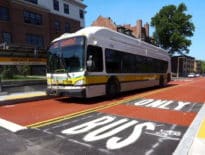The share of New England workers doing their jobs remotely has leveled off, according to research presented to a conference organized by the Federal Reserve Bank of Boston last week.
The event was convened to consider how pandemic effects like the emergence of hybrid work and changes in where people live will impact housing, commuting and the overall economy in New England.
Jeffrey Thompson from the New England Public Policy Center at the Boston Fed presented a data set showing that the share of full-time workdays conducted remotely has essentially plateaued around 30 percent in New England and another that showed occupancy rates for downtown office buildings hovering at 50 percent or below. While those facts are consistent with each other, he said, the two sets of data “let my imagination go to different places.”
Thompson also explained how many smaller New England cities came to be former hubs of manufacturing.
“This is a story of 60 years of change in what our economies look like. Back in 1960, New England was substantially more reliant on manufacturing labor than the rest of the country. And, in fact, we have over 60 years now come into almost perfect alignment with the rest of the country in that manufacturing has shrunk. We don’t manufacture nearly as much,” Thompson said. “What we do instead is we now have a service-dominated economy. And what we have seen is that in the New England region, that services — professional and related services, so this contains the innovation economy, this contains the sectors that demand high skills and pay high wages — we in fact have surpassed the rest of the country adapting to this new reality, to this new economy.”
He added, “So we have adjusted to dramatic transformations in the past. And are we up for the challenge? I think we are, but it’s going to be quite a lot of work. There’s a big curveball thrown at us in terms of how and where what will happen.”
With the 30 percent remote work stats, he said, “I start to think, OK, is this a story of differentiation, an even further splits in the workforce? We have a bunch of fully remote workers who are gonna go off and live at the lake house in Vermont and phone into their home in Boston. We have big, big issues regarding equity in terms of some workers that need to show up and other workers who have the luxury of working from their laptop. If that’s the future, that brings some challenges with it. I don’t know that that’s the future.”
But considering the office space occupancy rates, “makes me think a little differently. Is the future instead actually just more flexibility in work. And so you still have the same basic geographic spatial footprint of today’s economy, but with more flexibility. So your suburban worker, instead of coming in five days a week or four, instead they’re coming in two to three. So that’s a different picture of the future. It still has implications for transportation infrastructure, it has implications for real estate, for physical location, downtown business health — but it’s a different story.”
John Ballantine from Brandeis International Business School, who served as moderator Thursday, said the point of the conference was not necessarily to solve the region’s problems or predict its future, but to start getting people to think creatively about solutions.
Boston Fed President Susan M. Collins opened the conference by highlighting the work the Boston Fed has been doing through its Working Places Challenge to encourage economic resurgence in parts of New England that “have struggled to reimagine and rebuild their economies” after the decline of industries like manufacturing.
“If we are to move toward a more inclusive economy over time, the capacity for low-income places to adapt to economic change, which Working Places supports, is ever more important. This is particularly true in the context of the kinds of changes in housing and work we are discussing at today’s conference,” Collins said.
Through the program, the Fed supports a competition among cities and towns for grant money provided by states, the private sector and philanthropists to address a “shared goal for improving the economy that benefits low-income people.” Thirty communities across five New England states have participated since 2014.






